Zang Li
MixDec Sampling: A Soft Link-based Sampling Method of Graph Neural Network for Recommendation
Feb 12, 2025Abstract:Graph neural networks have been widely used in recent recommender systems, where negative sampling plays an important role. Existing negative sampling methods restrict the relationship between nodes as either hard positive pairs or hard negative pairs. This leads to the loss of structural information, and lacks the mechanism to generate positive pairs for nodes with few neighbors. To overcome limitations, we propose a novel soft link-based sampling method, namely MixDec Sampling, which consists of Mixup Sampling module and Decay Sampling module. The Mixup Sampling augments node features by synthesizing new nodes and soft links, which provides sufficient number of samples for nodes with few neighbors. The Decay Sampling strengthens the digestion of graph structure information by generating soft links for node embedding learning. To the best of our knowledge, we are the first to model sampling relationships between nodes by soft links in GNN-based recommender systems. Extensive experiments demonstrate that the proposed MixDec Sampling can significantly and consistently improve the recommendation performance of several representative GNN-based models on various recommendation benchmarks.
PSM-SQL: Progressive Schema Learning with Multi-granularity Semantics for Text-to-SQL
Feb 07, 2025
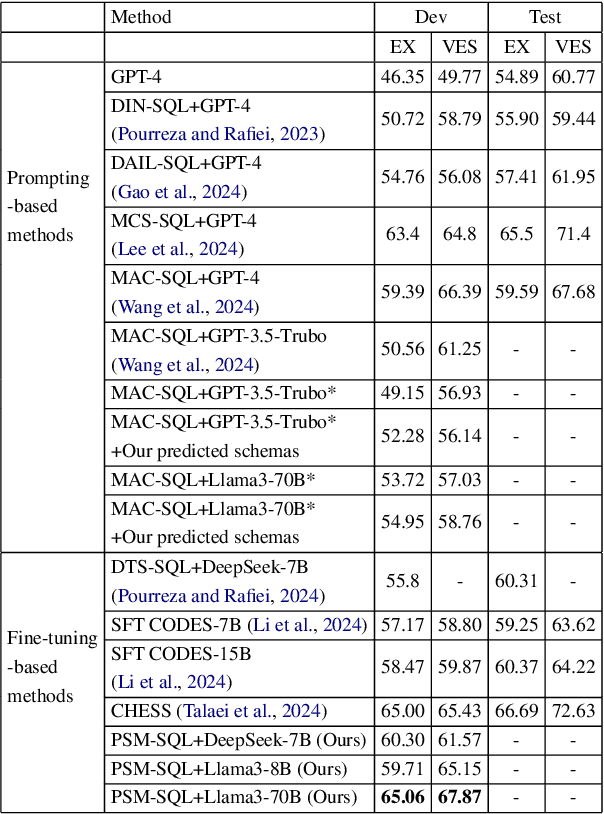

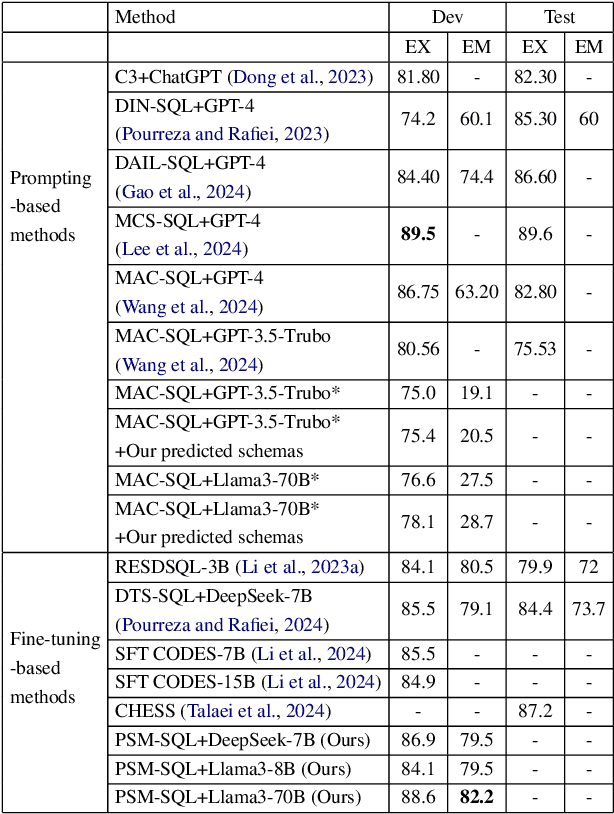
Abstract:It is challenging to convert natural language (NL) questions into executable structured query language (SQL) queries for text-to-SQL tasks due to the vast number of database schemas with redundancy, which interferes with semantic learning, and the domain shift between NL and SQL. Existing works for schema linking focus on the table level and perform it once, ignoring the multi-granularity semantics and chainable cyclicity of schemas. In this paper, we propose a progressive schema linking with multi-granularity semantics (PSM-SQL) framework to reduce the redundant database schemas for text-to-SQL. Using the multi-granularity schema linking (MSL) module, PSM-SQL learns the schema semantics at the column, table, and database levels. More specifically, a triplet loss is used at the column level to learn embeddings, while fine-tuning LLMs is employed at the database level for schema reasoning. MSL employs classifier and similarity scores to model schema interactions for schema linking at the table level. In particular, PSM-SQL adopts a chain loop strategy to reduce the task difficulty of schema linking by continuously reducing the number of redundant schemas. Experiments conducted on text-to-SQL datasets show that the proposed PSM-SQL is 1-3 percentage points higher than the existing methods.
Solid-SQL: Enhanced Schema-linking based In-context Learning for Robust Text-to-SQL
Dec 17, 2024Abstract:Recently, large language models (LLMs) have significantly improved the performance of text-to-SQL systems. Nevertheless, many state-of-the-art (SOTA) approaches have overlooked the critical aspect of system robustness. Our experiments reveal that while LLM-driven methods excel on standard datasets, their accuracy is notably compromised when faced with adversarial perturbations. To address this challenge, we propose a robust text-to-SQL solution, called Solid-SQL, designed to integrate with various LLMs. We focus on the pre-processing stage, training a robust schema-linking model enhanced by LLM-based data augmentation. Additionally, we design a two-round, structural similarity-based example retrieval strategy for in-context learning. Our method achieves SOTA SQL execution accuracy levels of 82.1% and 58.9% on the general Spider and Bird benchmarks, respectively. Furthermore, experimental results show that Solid-SQL delivers an average improvement of 11.6% compared to baselines on the perturbed Spider-Syn, Spider-Realistic, and Dr. Spider benchmarks.
L^2CL: Embarrassingly Simple Layer-to-Layer Contrastive Learning for Graph Collaborative Filtering
Jul 19, 2024Abstract:Graph neural networks (GNNs) have recently emerged as an effective approach to model neighborhood signals in collaborative filtering. Towards this research line, graph contrastive learning (GCL) demonstrates robust capabilities to address the supervision label shortage issue through generating massive self-supervised signals. Despite its effectiveness, GCL for recommendation suffers seriously from two main challenges: i) GCL relies on graph augmentation to generate semantically different views for contrasting, which could potentially disrupt key information and introduce unwanted noise; ii) current works for GCL primarily focus on contrasting representations using sophisticated networks architecture (usually deep) to capture high-order interactions, which leads to increased computational complexity and suboptimal training efficiency. To this end, we propose L2CL, a principled Layer-to-Layer Contrastive Learning framework that contrasts representations from different layers. By aligning the semantic similarities between different layers, L2CL enables the learning of complex structural relationships and gets rid of the noise perturbation in stochastic data augmentation. Surprisingly, we find that L2CL, using only one-hop contrastive learning paradigm, is able to capture intrinsic semantic structures and improve the quality of node representation, leading to a simple yet effective architecture. We also provide theoretical guarantees for L2CL in minimizing task-irrelevant information. Extensive experiments on five real-world datasets demonstrate the superiority of our model over various state-of-the-art collaborative filtering methods. Our code is available at https://github.com/downeykking/L2CL.
CTRL: Continuous-Time Representation Learning on Temporal Heterogeneous Information Network
May 11, 2024Abstract:Inductive representation learning on temporal heterogeneous graphs is crucial for scalable deep learning on heterogeneous information networks (HINs) which are time-varying, such as citation networks. However, most existing approaches are not inductive and thus cannot handle new nodes or edges. Moreover, previous temporal graph embedding methods are often trained with the temporal link prediction task to simulate the link formation process of temporal graphs, while ignoring the evolution of high-order topological structures on temporal graphs. To fill these gaps, we propose a Continuous-Time Representation Learning (CTRL) model on temporal HINs. To preserve heterogeneous node features and temporal structures, CTRL integrates three parts in a single layer, they are 1) a \emph{heterogeneous attention} unit that measures the semantic correlation between nodes, 2) a \emph{edge-based Hawkes process} to capture temporal influence between heterogeneous nodes, and 3) \emph{dynamic centrality} that indicates the dynamic importance of a node. We train the CTRL model with a future event (a subgraph) prediction task to capture the evolution of the high-order network structure. Extensive experiments have been conducted on three benchmark datasets. The results demonstrate that our model significantly boosts performance and outperforms various state-of-the-art approaches. Ablation studies are conducted to demonstrate the effectiveness of the model design.
Decomposition for Enhancing Attention: Improving LLM-based Text-to-SQL through Workflow Paradigm
Feb 16, 2024Abstract:In-context learning of large-language models (LLMs) has achieved remarkable success in the field of natural language processing, while extensive case studies reveal that the single-step chain-of-thought prompting approach faces challenges such as attention diffusion and inadequate performance in complex tasks like text-to-SQL. To improve the contextual learning capabilities of LLMs in text-to-SQL, a workflow paradigm method is proposed, aiming to enhance the attention and problem-solving scope of LLMs through decomposition. Specifically, the information determination module for eliminating redundant information and the brand-new prompt structure based on problem classification greatly enhance the model's attention. Additionally, the inclusion of self-correcting and active learning modules greatly expands the problem-solving scope of LLMs, hence improving the upper limit of LLM-based approaches. Extensive experiments conducted on three datasets demonstrate that our approach outperforms other methods by a significant margin. About 2-3 percentage point improvements compared to the existing baseline on the Spider Dev and Spider-Realistic datasets and new SOTA results on the Spider Test dataset are achieved. Our code is available on GitHub: \url{https://github.com/FlyingFeather/DEA-SQL}.
Olapa-MCoT: Enhancing the Chinese Mathematical Reasoning Capability of LLMs
Dec 29, 2023Abstract:CoT (Chain-of-Thought) is a way to solve reasoning problems for LLMs . Recently, many researches appear for improving the CoT capability of LLMs. In this work, we also proposed Olapa-MCoT, which is a LLMs based on llama2-13B PLM for finetuning and alignment learning. During the alignment training, we proposed the SimRRHF algorithm and Incorrect Data Relearning and mainly focused on optimizing the Chinese mathematical reasoning ability of Olapa-MCoT. The experiment achieved significant results, with the accuracy of Chinese mathematical reasoning up to 50%, 36% rise compared to llama2-13B. In addition, the accuracy of English reasoning ability also increased by nearly 4%.
OlaGPT: Empowering LLMs With Human-like Problem-Solving Abilities
May 23, 2023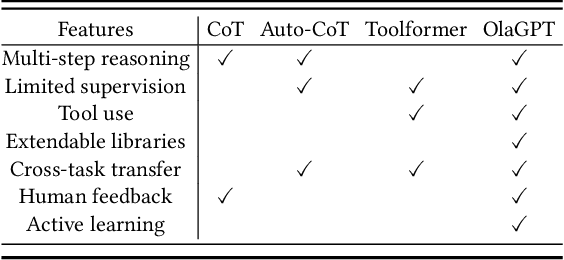

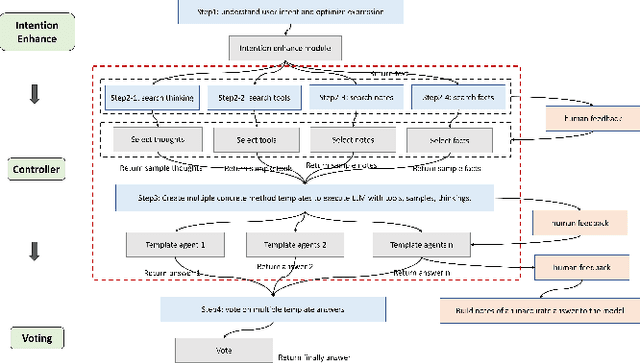

Abstract:In most current research, large language models (LLMs) are able to perform reasoning tasks by generating chains of thought through the guidance of specific prompts. However, there still exists a significant discrepancy between their capability in solving complex reasoning problems and that of humans. At present, most approaches focus on chains of thought (COT) and tool use, without considering the adoption and application of human cognitive frameworks. It is well-known that when confronting complex reasoning challenges, humans typically employ various cognitive abilities, and necessitate interaction with all aspects of tools, knowledge, and the external environment information to accomplish intricate tasks. This paper introduces a novel intelligent framework, referred to as OlaGPT. OlaGPT carefully studied a cognitive architecture framework, and propose to simulate certain aspects of human cognition. The framework involves approximating different cognitive modules, including attention, memory, reasoning, learning, and corresponding scheduling and decision-making mechanisms. Inspired by the active learning mechanism of human beings, it proposes a learning unit to record previous mistakes and expert opinions, and dynamically refer to them to strengthen their ability to solve similar problems. The paper also outlines common effective reasoning frameworks for human problem-solving and designs Chain-of-Thought (COT) templates accordingly. A comprehensive decision-making mechanism is also proposed to maximize model accuracy. The efficacy of OlaGPT has been stringently evaluated on multiple reasoning datasets, and the experimental outcomes reveal that OlaGPT surpasses state-of-the-art benchmarks, demonstrating its superior performance. Our implementation of OlaGPT is available on GitHub: \url{https://github.com/oladata-team/OlaGPT}.
Tenrec: A Large-scale Multipurpose Benchmark Dataset for Recommender Systems
Oct 20, 2022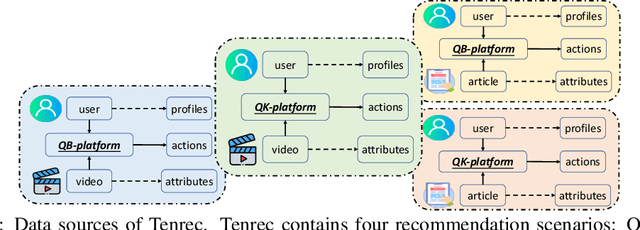
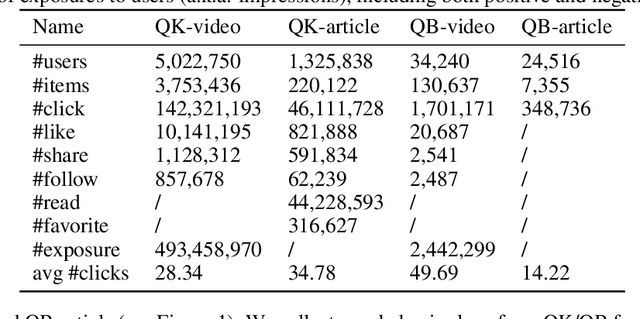


Abstract:Existing benchmark datasets for recommender systems (RS) either are created at a small scale or involve very limited forms of user feedback. RS models evaluated on such datasets often lack practical values for large-scale real-world applications. In this paper, we describe Tenrec, a novel and publicly available data collection for RS that records various user feedback from four different recommendation scenarios. To be specific, Tenrec has the following five characteristics: (1) it is large-scale, containing around 5 million users and 140 million interactions; (2) it has not only positive user feedback, but also true negative feedback (vs. one-class recommendation); (3) it contains overlapped users and items across four different scenarios; (4) it contains various types of user positive feedback, in forms of clicks, likes, shares, and follows, etc; (5) it contains additional features beyond the user IDs and item IDs. We verify Tenrec on ten diverse recommendation tasks by running several classical baseline models per task. Tenrec has the potential to become a useful benchmark dataset for a majority of popular recommendation tasks.
TransRec: Learning Transferable Recommendation from Mixture-of-Modality Feedback
Jun 13, 2022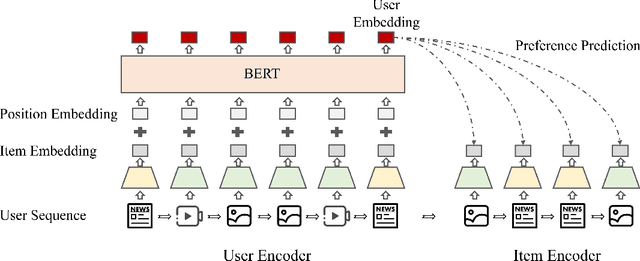
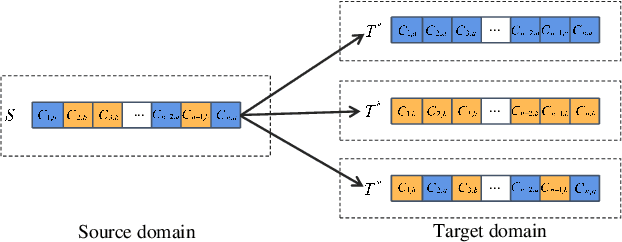


Abstract:Learning big models and then transfer has become the de facto practice in computer vision (CV) and natural language processing (NLP). However, such unified paradigm is uncommon for recommender systems (RS). A critical issue that hampers this is that standard recommendation models are built on unshareable identity data, where both users and their interacted items are represented by unique IDs. In this paper, we study a novel scenario where user's interaction feedback involves mixture-of-modality (MoM) items. We present TransRec, a straightforward modification done on the popular ID-based RS framework. TransRec directly learns from MoM feedback in an end-to-end manner, and thus enables effective transfer learning under various scenarios without relying on overlapped users or items. We empirically study the transferring ability of TransRec across four different real-world recommendation settings. Besides, we study its effects by scaling the size of source and target data. Our results suggest that learning recommenders from MoM feedback provides a promising way to realize universal recommender systems. Our code and datasets will be made available.
 Add to Chrome
Add to Chrome Add to Firefox
Add to Firefox Add to Edge
Add to Edge